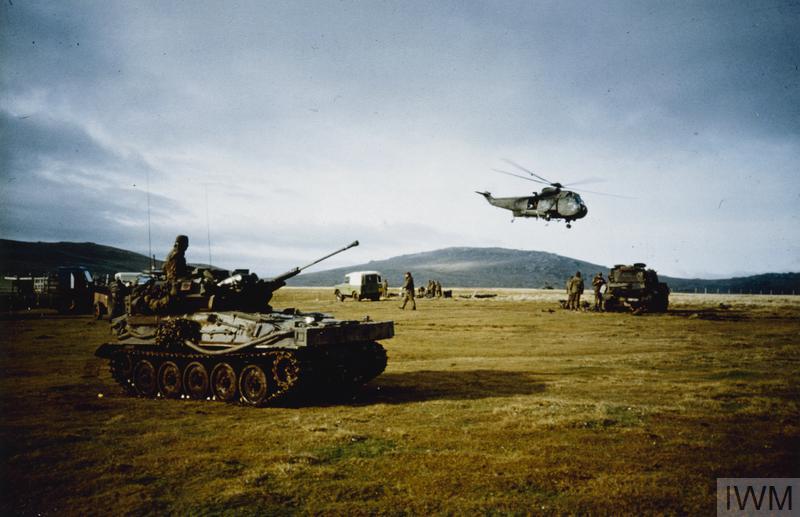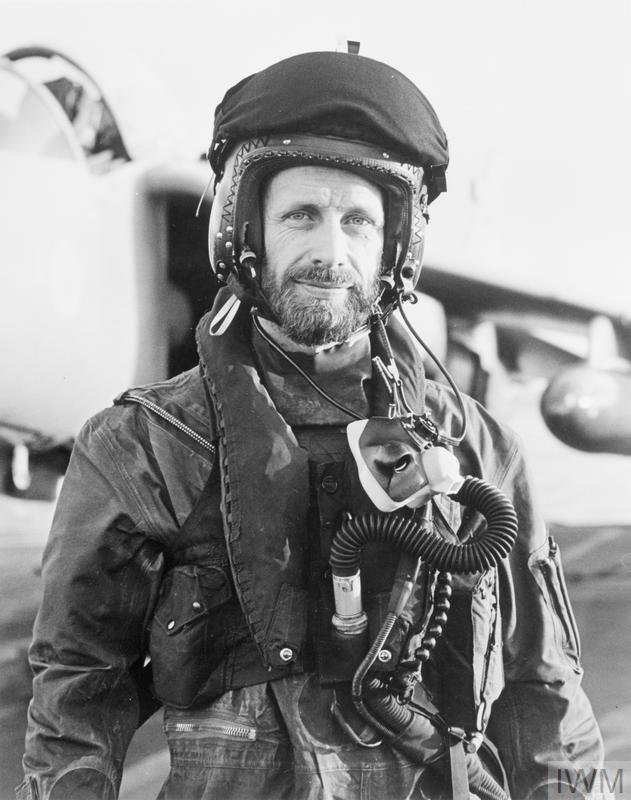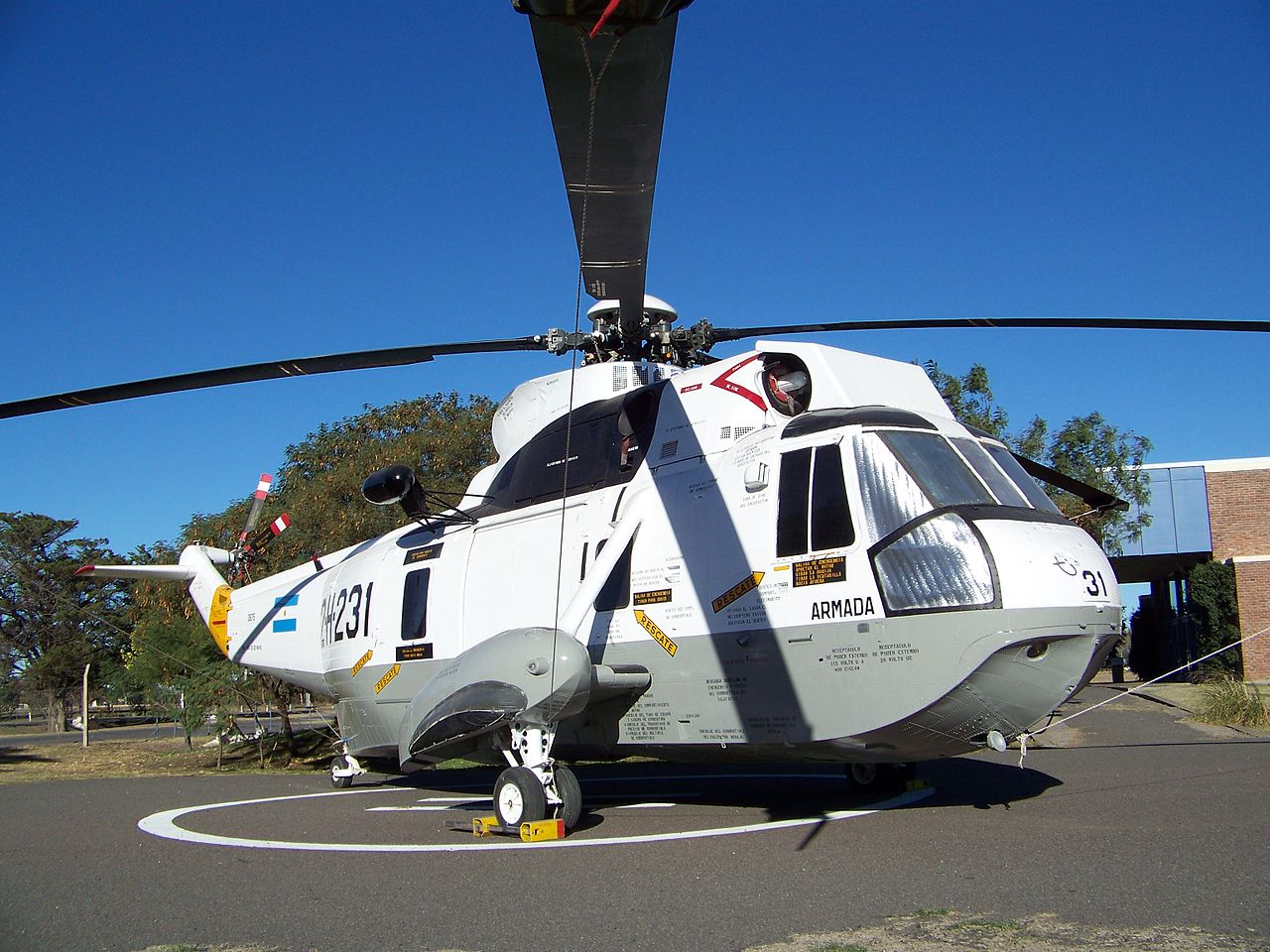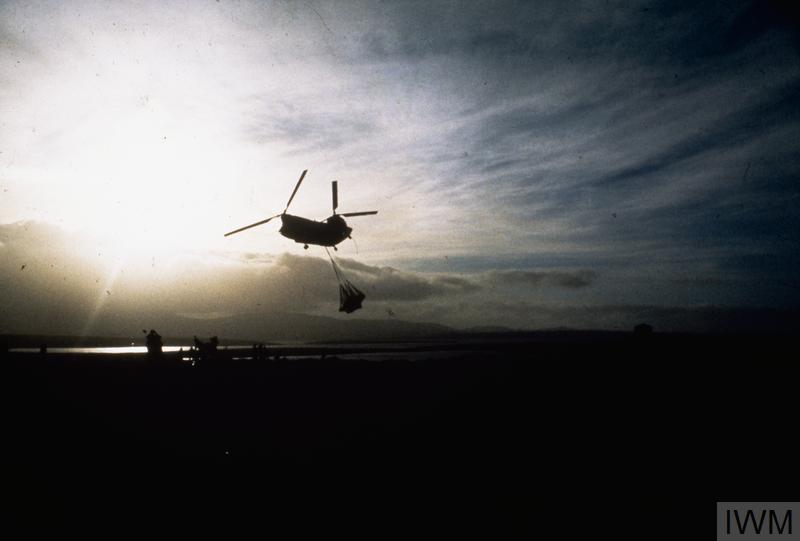In early April 1982, Argentina invaded the Falkland Islands, a few desolate rocks in the South Atlantic. The British mobilized their fleet in response. After a fierce battle in the air and at sea, the British gained the upper hand, and began landing troops on May 21st at San Carlos Water on the west coast of East Falkland. The Argentinians attempted to defeat the invasion with air attacks, but the British eventually gained the upper hand. On the 28th, the British, despite some setbacks, began the ground campaign, defeating the Argentinian garrison at Goose Green and opening the way to lay siege to the main enemy positions near Stanley.1

British forces near Teal Inlet, with Mount Kent in the background
The night of June 1st saw several important arrivals near the Falklands. On the north coast, a pair of LCVPs and an LCU from Intrepid arrived at Teal Inlet, the LCVPs sweeping for mines (they found none) and the LCU bearing the first 100 tons of supplies for the new forward logistics base. At San Carlos, Atlantic Causeway arrived, bearing supplies, vehicles, and equipment, most notably two dozen extra helicopters that would go a long way towards replacing those lost on Atlantic Conveyor. Ashore, engineers were assembling a primitive airfield from prefabricated matting, which would allow Harriers to operate from San Carlos, greatly increasing the time they could spend on CAP. Norland brought the Gurkhas2 of 5 Infantry Brigade, while other ships began to land the brigade's equipment. Unlike the earlier landings, everything had to go by boat, as the helicopters were all committed to supporting 3 Commando Brigade on the front lines, particularly 42 Commando on Mount Kent, which finally received adequate rations and equipment, as well as reinforcements.
The Argentinian Air Force flew several long-range recon missions on the morning of the 1st. A 707 was sighted near South Georgia, but didn't get close enough for Antrim to engage. Minerva, stationed at San Carlos, picked up a low-flying aircraft and vectored the Harrier CAP onto it, even though the jets were low on fuel. They discovered a C-130 and gave chase as the Argentine transport ran for safety. "Sharkey" Ward, flying the lead jet, managed to get within range, and dispatched the Hercules with a Sidewinder and 30mm cannon fire, killing all seven aboard. He and his wingman managed to make the 180-mile flight back to Invincible on only 45 gallons of fuel each, which would have been impossible without wartime experience in fuel management. To prevent this from happening again, the helicopter refueling systems on Fearless and Intrepid, still in San Carlos, were modified to support Harriers, and plans were made to land the jets on their decks.

"Sharkey" Ward with his Harrier
The task force also received reinforcements direct from Ascension on the 1st. A pair of Harrier GR3s were flown in, refueled by Victor tankers, while a C-130 completed the 21st in a series of long-range supply missions to drop urgent supplies and personnel. The most notable arrival was Lieutenant Colonel D.R. Chaundler, who would take over command of 2 Para. While Chaundler and the others who jumped with him were swiftly fished out of the water, others weren't so lucky. A Harrier returning from CAP ventured too close to Port Stanley and was shot down by a Roland SAM. The pilot ejected, but he was too close to the Argentinians to be rescued before nightfall. An Argentinian Chinook searched for him in the wrong place, and he was finally picked up by a British Sea King after 11 hours in the water.
The Argentine Navy also operated Sea Kings, and on May 31st, two had been dispatched to Pebble Island to evacuate the remaining naval aviation personnel there. The British had seen them arrive, but had missed their departure, and there was serious concern that the aircraft had been modified to carry Exocet missiles3 or that they would attempt to impersonate British Sea Kings and sneak up on the Task Force. As a result, the carriers stayed well back until it was confirmed that there were no helicopters at Pebble Island, which took until the 8th as a result of bad weather. To deal with the second threat, the British helicopters had to perform elaborate "delousing" procedures to verify their identity, and several were held at machine gun-point until they could convince their mothership that they were genuine.

An Argentine Navy Sea King
The night of the 1st and the early hours of the 2nd saw the usual shuffle of vessels around the Falklands on transport and bombardment missions. The most notable arrival was Canberra, ferrying the Guards battalions of 5 Infantry Brigade from South Georgia. Fortunately, San Carlos was shrouded in fog to protect from Argentine air attacks, although it lifted in the afternoon. The unloading was rather leisurely compared to the effort on the 21st, hindered by the Guards not unloading their own personal baggage. As a result, Canberra had to spend an extra day in San Carlos. To make matters worse for the British, the weather to the east of the Falklands was horrible, limiting them to only 9 Harrier sorties. Fortunately, the Argentine Air Force stayed on the ground.
With the northern flank of their advance anchored by the arrival of the LSL Sir Percivale at Teal Inlet overnight, the British pushed forward in the South. A flight of Scout helicopters carried a small party from 2 Para forward to Swan Inlet, about 15 miles east of Goose Green. There, Major J. Crosland made a phone call to Fitzroy, on an inlet just to the south of the forward British forces on Mount Kent, to ask if the Argentinians were still there. When he was informed that they weren't, 2 Para's leadership decided to secure Fitzroy via a coup de main. They commandeered the sole Chinook available to the British in the Falklands, and loaded it with 81 Paras. The overloaded Chinook4 made it to Fitzroy safely, and then returned with 75 more on a second trip. By nightfall, the British had 2 companies around Fitzroy, and a new deepwater anchorage 15 miles from Stanley.

Chinook Bravo November brings supplies to Fitzroy
The evening saw more operations around the Falklands, most notably an attempt by Cardiff to down the evening C-130 resupplying Stanley. Unfortunately, the Argentine aircraft was warned of the destroyer's presence, and managed to evade the long-range Sea Dart. The highlight of the 3rd was another Black Buck raid on the AN/TPS-43 radar that had proved so troublesome for the British. Unfortunately, the Sea Harriers were unable to support the mission due to the weather, and the Argentinians simply shut down their radar, leaving the Vulcan to duel with the 35mm AA guns guarding the airfield before expending its Shrike missiles on their targeting radars. Unfortunately, the Vulcan's refueling probe broke during the single refueling required on the return trip, leaving the crew with barely enough fuel to reach Rio de Janeiro. The Brazilians impounded the aircraft and crew, releasing them only when an agreement was reached that it would not take any further part in the campaign.5
The rest of the 3rd was quiet, as the weather kept all fixed-wing combat aircraft grounded throughout the day. The British decided to use this window to search for the land-based Exocets around Port Stanley, but the hunt was interrupted when Minerva's Lynx had a close encounter with a Roland SAM and promptly withdrew. The only other encounter between the two sides was a thousand miles northeast, when Engadine was overflown by one of the Argentines' Boeing 707s, although neither side was able to do much about it. Ashore, the British pushed forward, the Gurkhas taking over from 2 Para at Goose Green, while 45 Commando was ferried forward from Teal Inlet to the front lines and Sir Percivale finished unloading supplies there, returning to San Carlos.
The first days of June had seen the British solidify their position around Stanley, gaining an important foothold on the southern flank at Fitzroy as well as three extra battalions of troops. However, the unplanned advance also left them overextended, a situation that would see them scrambling to catch up. We'll pick up the story there next time.
1 For more information on ships and aircraft, as well as links to the whole series, see my Falklands Glossary. ⇑
2 Gurkhas are Nepalis recruited by the British and Indian armies with a truly ferocious reputation for bravery in battle. ⇑
3 Iraq had done this as part of the ongoing Iraq-Iran War. ⇑
4 Normal capacity of 55 passengers. ⇑
5 Only 5 aircraft were modified for the Black Buck missions, and it's quite possible that the bomber, XM597, was one of only two that were modified to carry Shrikes, the other serving as reserve aircraft. Interestingly, the integration of the Shrikes was done by people who were said to be South Africans, but had American accents. ⇑

Comments
Just been reading a bit about RN mine warfare in the Falklands era. The elderly Ton-class coastal minesweepers (built in the 1950s) were considered unsuitable for the long voyage south or for the conditions expected once they got there, and the new Hunt-class ships weren't ready yet. Instead, minesweeping equipment and crews were taken from 5 Ton-class ships and placed in 5 requisitioned deep-sea fishing vessels. There's an interesting article about this aspect of the war here.
(I was reading about the Ton-class because I recently found out that one of them, HMS Fittleton, was the last wooden ship of the Royal Navy- and as far as I know of any navy- to sink with loss of life. Fittleton collided with the frigate HMS Mermaid while attempting to transfer mail in 1976.)
Thanks for sharing that. Unfortunately, the format I adopted for this series makes it hard to talk about things like mine warfare. In retrospect, I probably should have done a quicker overview, and then focused on specific aspects of the fighting instead of trying to chronicle everything.
It figures it would be Mermaid. The reason the RN starts screaming any time someone suggests buying a ship the original buyer has decided they don't want.
Yes, the Mermaid was a particularly weird ship- built as a heavily armed presidential yacht for Kwame Nkrumah of Ghana, then bought by the RN as a subsidy to the builders once the Ghanaians decided that the yacht- and Nkrumah- were no longer required. I don't think it was useful for much beyond showing the flag. While it was the only ship of its class, at least the hull and machinery were shared with other RN frigates...